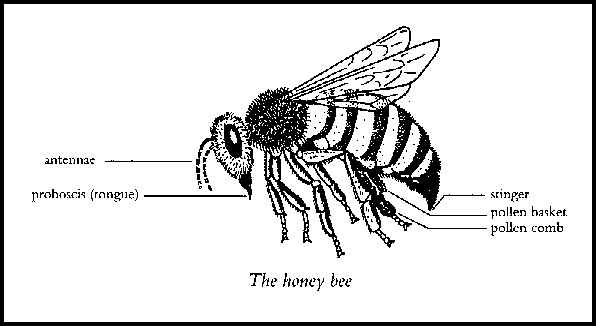
Fruitless
Fall
The Collapse of the Honey Bee and
The Coming Agricultural Crises
Rowan Jacobsen
(Bloomsbury)

These bees are dying like flies, and no one can figure out why. It is called CCD --- colony collapse disorder. Some say it is caused by cell phones which can freak out the homing ability of bees. Others blame IAPV, Israeli acute paralysis virus --- not to blame the Israelis but the Australians and Chinese, its main source. Still others blame it on Nosema ceranae, a fungus from god knows where. How about varona mites? --- "Picture going through life with a tick the size and shape of a kettle stuck to your back."The scariest of all theories centers on pesticides, most especially those known as neonicotinoids, nerve poisons. Their effect: "nerves fire when they shouldn't, while legitimate messages can't get through."
Disorientation, short-term memory loss, and loss of appetite are some of the first signs of acetylcholine [nerve receptor] breakdown, followed by tremors, spasms, and eventually paralysis and death.
"In people, Parkinson's and Alzheimer's are two diseases marked by inadequate acetylcholine reception."
Over the last fifteen years, while we weren't looking, imidacloprid --- the most popular form of neonicotinoid --- was licensed for use on 140 crops in a hundred countries, and "is now found in many of the bestselling pesticides in the world." And it ain't just out on the farm that we're running into this stuff: if you put Advantage on your pet, if you put Merit on your lawn or golf course "you are using imidacloprid, which will kill soil bugs without killing cats, dogs, toddlers, or duffers." Maybe.
A stroll through Wal-Mart will turn up plenty of imidacloprid, sometimes in unexpected products. Look for all-in-one flower care that promises protection from insects, as well as any kind of grub treatment that offers "season-long protection."
"The amount to cover an acre sells for twenty dollars in the United States, but in China it is just two dollars."
Is this the villain, the one that is killing all our friendly local fruit and vegetable pollinating bees? Perhaps, but more probably they are being done in by not only this but a deadly combination of insecticides with which you and I and our farmers and our government and our neighbors have been seeding our beloved planet starting, in the 1940s, with DDT. It is all beginning to catch up with us, this playing about with sprays and dusts and various fungicides and herbicides and pesticides.
Once upon a time we thought we could be rid of all the beesties that plagued the earth: horn-worms, cut-worms, mites, mealie bugs and weevils and beetles and those flying things that were plaguing our farms and our gardens. We figured we could spray them away. But we didn't figure on evolution.
Remember evolution? Your local preacher would rather not, but, unlike the innocent bee, these mites and bugs and worms and creepie-crawlies have evolved away from dying from our poisons, are now plotting how they can be done with us in the process. A Penn State entomologist who specializes in the effect of pesticides on honey bees told the author, "There is a lot of controversy about how much of the neonicotinoids gets into pollen and nectar. If you ask Bayer, they'll say very little. We're not convinced of that."
Sublethal doses of imidacloprid change bees' behavior, undermine the wisdom of the hive, and trigger CCD-like syndrome.
It's not conclusive, as they say, but it's enough for this reader. "One study found that ... bees that flew off stoned on imidacloprid died not directly from the chemical but because they couldn't find their way home and died of exposure."
Overexposure to these chemicals is like our national debt. What's the point at this late stage of condemning Bayer, BASF, Dow, Monsanto, DuPont and Syngenta of poisoning our world? Who would ever vote against a politician because he or she votes to add another trillion to our national debt? Yet these cruel legacies are sure to be poison to our children. Another trillion dollars of debt? Another million ppm of imidacloprid? "We can assume," writes Jacobsen, "that hundreds more toxic cocktails are being mixed every day in the world's fields and streams." And who of us can stop it?
It's not the bee-all (and end all). It certainly is not the bee's knees. But Fruitless Fall may be the bee-in-the-bonnet that we all need.
--- Janet Lassen